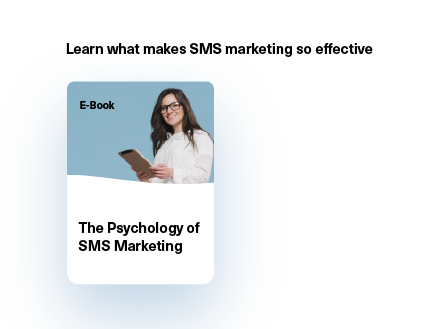It’s a rather multifunctional tool, the humble SMS. It is used for both form and function to deliver vital information or simply a strong message. We’ve all got several messages throughout the years and often in different ways. But often the use-cases themselves fall under three distinct categories - OTPs, transactional and promotional messages. All these types have different roles in customer journeys and are used at various stages, too. Let’s take a look at how.
One Time Passwords
The simple yet straightforward One Time
Password (OTP) is a very common use-case for SMS. Used for phone number
verification, transactional confirmations, 2FA, password recovery and package delivery
(e.g. at package lockers).
Due to the simplicity of access, the reach and
ease of integrating the tool into any CRM or platform, SMS is the most readily
used form of authentication for persons or transactions. It’s also one of the
most common instances we interact with SMS in our everyday lives and how many
customer journeys begin. It’s also one of the ways companies obtain the
client’s phone number and how they verify it for future use.
They also tend to be either the most expensive or cheapest type of messages.
This is because they are very time-sensitive - delivery issues and instability
in quality can significantly affect the customer experience. Hence the
connections used are the most direct ones and have a higher priority attached
to them. A route like that also costs more. But they are also the cleanest form
of traffic, with the least amount of issues attached to them relating to
opt-ins or content restrictions. Thus, they can also be the cheapest for that
reason, especially considering direct operator connections.
Examples:
Fairly
straightforward and simple, one of the most common forms that OTPs come in.
A transactional confirmation for a financial transaction. Another common form of OTPs. They are used to add another layer of security on top of large financial transactions.
Since not all markets allow for alphanumeric Sender ID-s, the brand name is used within the content of the message.
Used to verify both the person and the activity they wish to partake in. Financial activities most often rely on SMS as a critical tool in enabling another level of security and go a long way in helping prevent fraud.
Transactional SMS
While SMS in an OTP form is used in the transactional process quite often, transactional SMS themselves tend to be the most frequented by the customers. From notifications on delivery times and steps to take in the setup process, to invoice reminders and appointment details - SMS is used for any manner of quick info delivery.
Since the delivery times are usually within seconds, it can easily be triggered for specific times and occasions when you want some information to go out or think it would be reasonable to update your client on the progress. It’s a quick update and a cheap add-on to include in the sign-up or service process that gives assurances to the client that your product is working as they hope it would.
Pricing wise they tend to be in the middle range. They still need to get there every time, but a small delay can be okay. For example, it’s fine if a doctor appointment reminder is received a minute later than triggered, especially if you trigger it to arrive a day before the actual appointment.
As such, the pricing tends to be in the middle of the road with the broadest means of delivery. The content is easy to manage with few regulations in the way and since the delivery doesn’t always need every single minute detail to be perfect, the connection pricing can be cheaper as well. At the same time, they still all need to be delivered and within a reasonable amount of time, be trackable and have the delivery reports attached.
Examples:
Appointment reminders, be it to get your car serviced or to see the dentist, are super common. It helps reduce the no-shows in a simple and cheap manner, saving money on each message delivered.
Anything related to travel, from booking confirmations to travel details and car lease deadlines are delivered via SMS. You can also embed links to ensure that the client finds the right place to go and can continue their journey.
An emergency notice delivered from a connected device or platform, that helps to get a quick hold of situations such as power outages or process shutdowns.
The public sector often utilises SMS for vital information delivery, especially for matters about documents, registrations or other important details that people need to keep an eye on or face fines.
Promotional messages
Marketing messages are pretty obvious in their
most common form, be it an offer, a coupon or some other type of incentive
designed to entice the customer to buy a product or pay for a service. But
these can also be feedback requests, news updates about the product that aren’t
crucial to the workings of the product or service (such as service interruption
updates).
Learn more about SMS marketing in our expert's guide!
Unfortunately, these messages are hampered by the largest amount of legislative restrictions, carrier restrictions or content restrictions set on the types of messages that are allowed. The most common ones are messages limiting gambling, adult content and political messages. There are often restrictions on the time that a message can go out (particular times of day for example, such as in France), and what needs to be added to the content, such as unsubscribe links in the EU.
If you choose legitimate operator connections, designed for direct delivery, then marketing messages will likely cost you the most. But they are often the cheapest ones sold because their delivery rate is not always needed to be 100% and the price per message is much more important.
Grey routes are often used as substitutes,
which we don’t recommend. They boast a 40-70% delivery rate, are cheaper and
can quite quickly get your company banned from ever sending messages to an
operator’s network. While you could save some money here, the shadiness of the
delivery circumstances, the instability of delivery and lowered delivery
quality, the risk of being banned permanently along with your transactional and
OTP traffic as well, should make the choice towards paying more quite obvious.
Examples:
Here’s where things get a bit trickier since promotional messages can in addition to inviting you to purchase a product with the lure of a discount also promote trying something out or sending feedback to improve the service.
A very common holiday-related promotional message that is designed to entice a person into buying from the sender, considering they are planning to spend some money anyway (might as well save a bit on those Christmas presents).
In a way, it’s both a notification and a promotional message, because it invites you to check out their new website and lets you know of some key details about a service that you have used in the past. This can also nudge a person towards thinking of the last time they had a check-up and book an appointment.
Asking for feedback and using that to funnel clients to your website and learn about the shortcomings of the product. Enticing with prizes is an excellent way to get them to spend their time on your request.
Event promotion is also a common source of SMS marketing messages. Simple yet effective, especially when you time them to trigger on a sunny weekend day.
Conclusion
All in all, our customers stumble upon a variety of different messages from content to type, but at the same time, they all fit into three distinct categories that all come with restrictions, limitations and a price attached. Having a direct line to an operator or as short of a delivery chin as possible is always a good idea since that leads to solid delivery and trackable performance for all steps in the customer’s journey.
There are a fair few ways to tailor your customer journey with SMS messages. Ask them to sign up via an SMS offering a discount. Have them verify themselves via an OTP. Ask them to confirm a transaction via SMS, then ask for their feedback and give them a reason to come back. All from the same familiar channel that they’ll get used to interacting with daily.

















